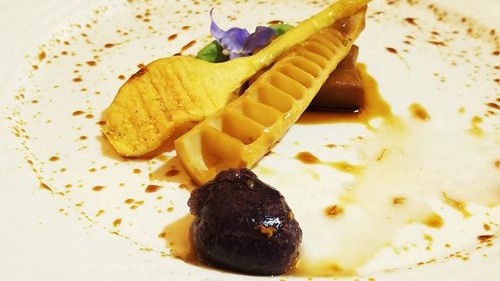
The 24 solar terms that are part of the traditional Chinese calendar were added to UNESCO's intangible cultural heritage list in November of 2017. These roughly two-week long periods were vital tools for farmers in ancient China since they acted as an almanac of sorts that allowed them to know what time of the year activities such as planting seeds and harvesting crops were to take place.
Well, it also seems that they can be used to plan what meal you should eat on a certain day, according to Chinese-Japanese gastronome Kiyono Sakashita.
Sakashita has caused quite a buzz among foodies with her recently opened restaurant in Beijing's 798 Art District that combines western culinary arts with the traditional solar terms to create her menu. Named Claret, or Ting Chu in Chinese (Lit: listening kitchen), the restaurant is trying everything it can to reestablish a strong connection between nature and people who live in bustling cities like Beijing through different seasonal tastes.
Natural rhythms
"The solar terms are a direct reflection of nature that guides people about what they should eat at a particular time of the year," explained Sakashita, who believes that the healthiest diet is to follow the rhythm of nature.
To put her beliefs into practice, Sakashita and her chef team tailor-designed their menu based on seasonal food appropriate for each of the solar terms. A standard menu consists of five courses made from ingredients that are closely related to that particular solar term.
For example, bamboo shoots play a key role in her latest menu as a play on an old Chinese saying that goes "Qing Ming (solar term that begins around April 4) sees bamboo shoots come out, while Grain Rain sees them grow." In China, most people consider Grain Rain, which begins in late April, to be the best time to eat bamboo shoots.
Moreover, each ingredient is used in creative ways during each course of the meal, making the dining experience much more interesting and fun. For the Grain Rain banquet, the starter consists of teriyaki spring bamboo shoots with arrowhead root, followed by homemade white asparagus soup with gorgon nut - another "best food" of the season - after which bamboo returns in a refreshing dish that combines bamboo fungus together with salted onions and elderberry cucumber.
The diversity on display isn't limited to how the food is presented, but also in each dish's richness of flavor and diet philosophy. For example, the sweet white asparagus soup has a subtle bitter after-taste, creating a unique flavor that helps to "remove internal heat" according to traditional Chinese medicine.
"It is believed that medicine and food have the same origins in Chinese culture and I think selecting food in accordance to natural rhythms is good for a human being's body," Sakashita explained.
Another highlight that attracts foodies is how the dishes are accompanied by more than a dozen hand-made seasonal sauces, including fried mushroom, olive fig and red pepper cashew sauces. To keep "the flavor of the seasons" pure and organic, processed products are not included on the menu and all the ingredients are free of additives and preservatives.
More than just food
This solar term theory isn't only applied to the dishes, but penetrates almost every detail of the entire dining experience, including the table settings, room decor and music.
To showcase the theme of Grain Rain, the table was decorated with greens, yellows, whites and pinks, while seasonal flowers such as peonies were delicately presented beside the kitchen, giving the room a sweet and refreshing smell. Paintings that highlight the season of spring were also hung on the walls.
"Time of eating good food should be spent with loved ones. Experiencing the changes of the seasons together is a pleasant thing," Sakashita said.
Spending her early childhood in Xi'an, Shanxi Province and growing up in Japan, Sakashita was deeply influenced by the two cultures. For this reason, the solar term banquet is also a fusion of the two countries' food cultures. The way each course is served, the introduction of small palate cleansers between the main course and the final dessert and the seasonal concept clearly reflect elements of Japan's multi-course haute cuisine known as kaiseki-ryori.



